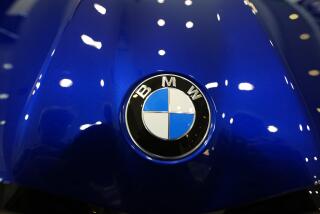BMW Must Pay $160,000 Lemon-Law Fine
- Share via
When a mechanical problem develops in a new car, all too often a dealer’s first response to a customer is that the condition is normal or that all the cars of that model have the same condition.
It can be infuriating to somebody who has laid out an investment of $10,000 or $20,000--tantamount to suggesting that if you don’t like the car, you might consider a horse.
A Santa Barbara Superior Court judge recently issued a stinging nine-page decision against a major automobile manufacturer that goes to the very heart of this consumer issue.
The decision came in what is believed to be the largest lemon-law award in U.S. history, involving a BMW 750i. As readers may recall, Pierre Forrest, a Beverly Hills businessman, claimed in his lawsuit last year that his BMW suffered repeated battery failures, including a malfunction on the first morning it was delivered to his mansion.
BMW said the car was fine. The German firm asserted that Forrest failed to drive the car enough, allowing the on-board computer to drain the battery. A Santa Barbara jury didn’t buy that rationale last year and awarded Forrest $160,000 in damages.
BMW then asked Judge Patrick L. McMahon to throw out the verdict, saying the jury erred. The judge’s answer was sharp and to the point.
“When a consumer purchases a new car of any type, he or she expects that it run properly when used in a reasonable manner. The BMW purchased by (Forrest) did not meet those expectations. Indeed, it was a lemon,” the judge wrote.
As for BMW’s defense that the condition was a normal aspect of BMWs, McMahon wrote, “. . . if all other cars of the same make, model and year are also lemons, the manufacturer is not entitled to immunity.”
BMW also pleaded that the award was out of line. But the figure assessed against BMW “was an attempt to quantify in monetary terms the immoral character of BMW’s own corporate policies,” the judge wrote.
Finally, McMahon suggested that BMW was guilty of an equestrian sort of attitude.
”. . . the BMW warranty did not disclose the problem. Predictably, the car constantly was in the shop. In this Modern Age, when a vehicle is defective, it is a rather hollow defense to tell the customer to get a horse,” he said.
Al Hodges, a Glendale attorney who represented Forrest in the case, said the judge “hit the nail on the head” by addressing for the first time in a court decision the common practice of auto makers in dismissing complaints as “normal” conditions in new cars.
A BMW spokesman said the firm was unhappy about the decision but would abide by it. “We were surprised by the language and would certainly take issue with it. At one point, he used the word immoral. We don’t view ourselves in that light.”
Question: Help. I have a 1984 Ford Escort that makes a flexing or popping sound from the right front end. Originally, it happened only when the car was stopping or starting. Now, the sound happens when the car goes over small bumps. What is it?
Answer: The problem could be a defective motor mount, a potentially serious problem that you should not ignore. The motor mounts are the support points that hold the engine firmly to the car’s frame.
The motor mounts are rubber insulated bolts, designed also to damp vibrations from the engine. Sometimes the rubber deteriorates and allows the engine to jump position by a slight amount when starting.
That creates a popping or flexing noise. A motor mount costs $26 and should take a qualified mechanic about 30 minutes to replace.
Another possible cause of the problem is a worn rubber insulator on the car’s stabilizer bar. The bar is part of the front suspension system, running from the body to the control arm for the wheel. It helps to keep the car stable, damping out swaying.
Ford issued a technical service bulletin in 1987, warning that the previous three years of Escort models could be affected by worn insulation on the stabilizer. It also warned that a spot weld on the arm was subject to breaking in hard use.
If you have a broken stabilizer bar, you would hear a snapping noise from the front. Replacing the bar should cost less than $100, not including a front-end alignment.






